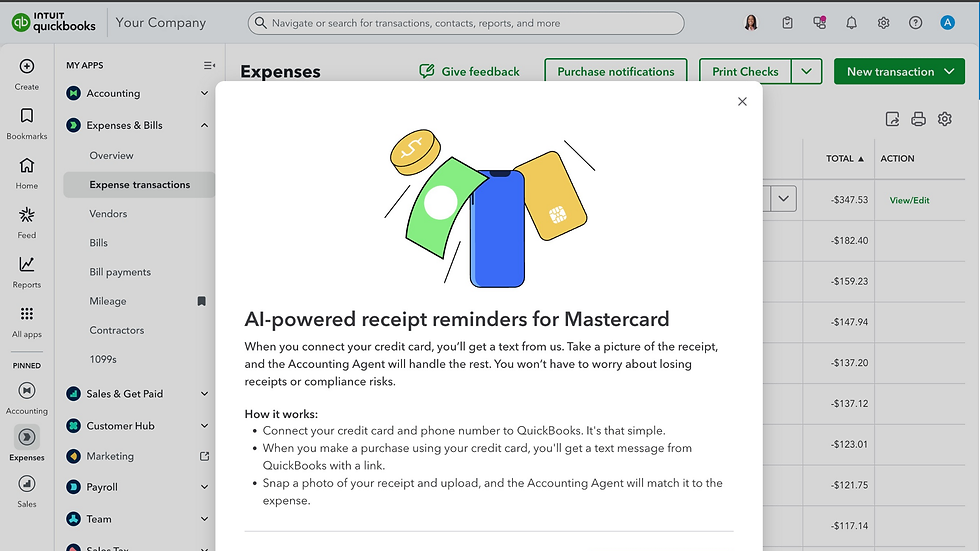How to Maintain Customer Records in QuickBooks Online
- Susan Cook

- Jan 27, 2022
- 4 min read
Updated: Oct 6, 2023
Your customers are the lifeblood of your business. Make sure their records are always thorough and up-to-date.
When a company acquires another business, the customer list is often the most critical asset to the buyer. When a business experiences physical or digital damage and critical company data is possibly lost, which set of records would you most hope to recover? The customer list. As a QuickBooks user, most of your time spent in the app is probably is focused on transactions and reports. However, your customer records deserve equal time and attention. Incomplete or poorly maintained customer files can cause you to lose significant time when working on a task that requires complete customer profiles. In addition, search queries and reports may not tell the whole picture without sufficient data. As a result, customer relationships can suffer and you could miss your best opportunity to sell your business in the future. QuickBooks Online provides excellent solutions for creating and maintaining comprehensive customer and sub-customer records. Below, we'll dive into the customer records feature and everything you need to know.
Moving Your Customer Data In
There are two ways to create customer records in QuickBooks Online: 1) to import a list from an existing database in another platform, and 2) to enter records manually. If you have an existing database in Outlook, Excel, Gmail, or Google Sheets, you can import it to QuickBooks Online. This will save you an enormous amount of time if your customer list is lengthy, but it’s a complicated process. Essentially, you select the file you want to import, and then you have to “map” it by matching the contact fields in your database to fields in QuickBooks Online. You’ll likely need our help with this.

To import a customer file into QuickBooks Online, you’ll have to “map” its fields. We can help you with this. Your other option is to enter records manually. This is time-consuming, but the more information you can include about your customers from the start, the better. You can always edit your records to add, delete, or modify the information you originally entered. To get started, hover over Sales in the toolbar and click on Customers. Then click on New Customer in the upper right corner to open the Customer information window. The only field you’re required to complete is Display name as. You may want to do this if you have a new customer on the phone and you want to concentrate on the conversation. You can take notes about their contact information and fill in the record later, when you’re off the phone. But wherever possible, as we’ve already said, complete as many fields as you can. You’ll enter their name, billing and shipping addresses, and phone number(s) on the opening screen. You can also supply contact details like a fax number and website.
Creating Sub-customers
You’ll notice a checkbox that says Is sub-customer. QuickBooks Online lets you “nest” related records under the “parent” record. This can be an actual customer, but many people also use it to document jobs they’re doing for the customer. So if you’re a contractor, for example, you might have sub-customers like Sun deck and Spa. If you want to set up such a record, enter the job name and click in the box next to Is sub-customer. Two fields will open below that allow you to select the parent customer and to indicate the sub-customer’s billing status. The remainder of the fields will automatically fill in with the parent customer’s contact information.

You can set up jobs as sub-customers in QuickBooks Online .
Supplying Details
When you’re setting up individual customers, you should add as much detail as you possibly can to each record, beyond basic contact information. QuickBooks Online’s record templates display a number of tabs running horizontally across the window. The most important of these are:
Tax info: Are the customers taxable or exempt? If taxable, what is their Default tax code? (If you haven’t set up sales tax yet and need to, please let us help. It’s complicated.)
Payment and billing: Does your customer have a preferred payment and/or delivery method? Will you be assigning default payment terms, like Net 30 or Due on receipt? What is their Opening balance? If they’re brand-new customers who have never ordered from you, this will be $0.00. If they’re existing, active customers, enter any outstanding balance they have with you as of the date that you enter. This must be correct, to avoid any problems with the customers’ ongoing balances. Questions? Ask us.
Other tabs here are self-explanatory. When you’ve entered everything you can, click Save. The new customer record will now appear in the Customers list and will be available to select from the drop-down list in transactions. Do you need to track more details regarding your customer records? Adding a custom field can help. You may even benefit from an upgrade to QuickBooks Online Advanced, which has expanded the use of this feature. There will be times when you have to refer back to these forms to answer questions. By maintaining detailed, accurate customer records, you’ll be ready to respond. If you have questions about any of the information requested, or about other elements of QuickBooks Online that are puzzling you, please contact us so we can set up a consultation.





Comments